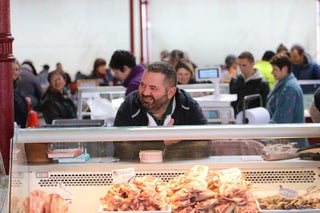Duck
Here in south west France, on the tables of Gascony, le canard reigns supreme. In part that’s due to the French folks love of foie gras, as once the foie is removed, the cook has the whole bird at their disposal. In times past the whole duck was confit - cooked in its own juices before being preserved under a layer of duck fat. Now, most duck confit is prepared from the leg and thigh portion, while the breast has been exalted to steak status, all due to a local chef caught short with no food to serve.

Back in the late 1950s, two-star Michelin Chef André Daguin, found his cupboard bare, when unexpected guests arrived at his restaurant, Hotel du France in the near-by, city of Auch, the historical capital of Gascony and home to the legendary Musketeers.
The story continues, that André grilled the duck breasts that were sitting ready to be confit, serving them like a steak. The resulting popularity of the magrets du canard grillé caught on and today the dish is as common here as chicken is in New Zealand. Duck breast always features on café menus, it’s the fall back option, a bit like a beef steak. For home cooks, duck breasts are available in the supermarket, plain, marinated or smoked and sliced like salmon, ideal for canapes. I tend to buy mine from the market where the jolly duck butcher, Christolfe, who looks like he knows his product, is always keen to practice Franglais with me, and I am duly thanked with a cadeaux of confit of gesiers ( gizzards)… mmmm.
Most magret in Gascony will come from the sizeable Moulard duck, which has been bred especially for the foie gras industry. A cross between the Muscovy and Peking duck the meaty breast portions, that weigh in at 450-500 grams per single breast, are flanked with a thick layer of fat that helps keep the lean breast meat moist while cooking.
Duck breast, regardless of origin, requires little attention in order to cook to perfection; salt and pepper its best partner. Score the fat layer deeply cutting all the way through to the meat. This is important to allow the heat to reach through to the meat when cooking. Season the fat layer well, rubbing flaky salt and ground black pepper liberally into the fat, the deep cuts as well as the meat. If the duck is not at room temperature, set aside for 20-30 minutes. Cooking meat, any meat, from room temperature ensures the meat cooks evenly and, when placed into a hot pan, will sizzle up nicely with no risk of the pan cooling down and the meat stewing.
Place the duck, fat side down first into a moderately hot pan. Once the fat begins to run, increase the temperature to high. Cooked this way, the thick layer of fat will gradually heat up, releasing fat into the pan. If there’s plenty of fat running out, drain it off to avoid it creating smoke fumes and setting off the smoke alarm! Cooking time depends on the thickness of the duck breast, but allow more time on the fat side as the heat has to permeate though the fat to the meat. Allow about 4-5 minutes on the fat side and 3-4 minutes on the meat side and then don’t forget to rest the duck breast on a warm plate to allow the juices to be absorbed back into the meat fibres.mDuck breast should be served pink, overcooked it will be like shoe leather.
Duck’s gentle gamey flavour is a great match to lentils, olives, oranges, walnuts and mint, all tossed together here to create a fabulous salad on which to present your magret du canard.


Comments (0)
Please login to submit a comment.